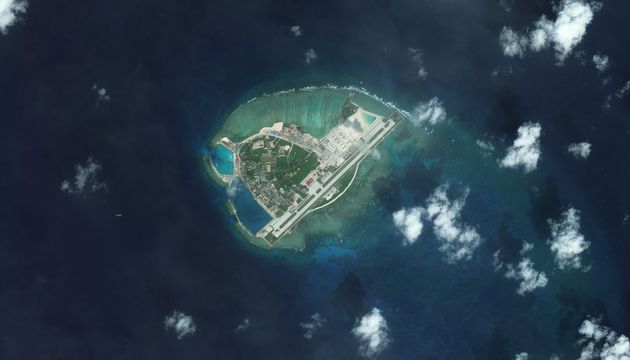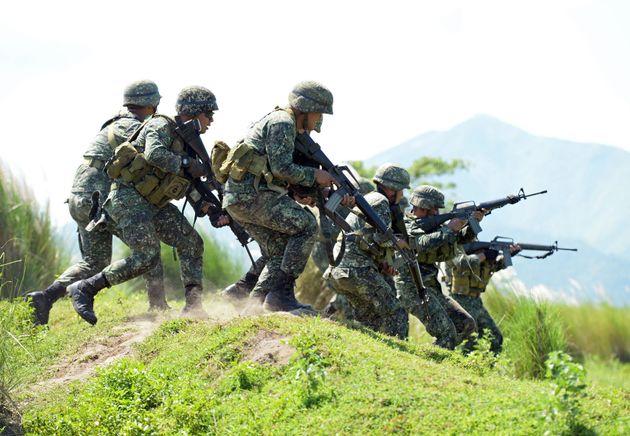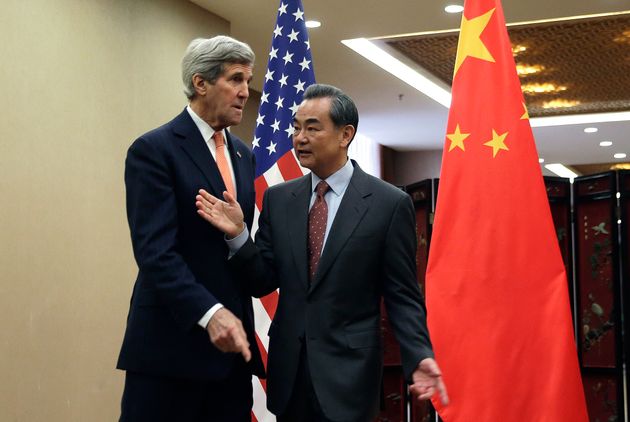Several countries have squabbled over the region's natural resources and trading routes for decades.

The South China Sea, a popular trading route that holds a mother lode of natural oil and gas reserves, has been a source of escalating tension in southeast Asia for decades. This photo shows Woody Island, a Chinese-controlled islet in the sea's Paracel islands.
The South China Sea has been a source of tensions between several East Asian countries for decades -- and the disputes are getting worse.
In recent years, China and some of its neighbors have ramped up their activities to stake a claim in the area, going as far as building new islands and installing airstrips for fighter and surveillance jets. China's military activities in the sea, in particular, have drawn the ire of the United States and contributed to strained relations between the two countries.
Here's what you need to know about what's happening in the South China Sea:
Where is the South China Sea?
The South China Sea is located at the western edge of the Pacific Ocean, to Asia's southeast. It encompasses an area of about 1.4 million square miles and contains a collection of reefs, islands and atolls, including the Spratly Islands, Paracel Islands and Scarborough Shoal.
Who is fighting over the area?
The South China Sea is surrounded by several southeastern Asian countries, including China, Taiwan, the Philippines, Malaysia, Indonesia and Vietnam -- all of which have made overlapping claims to territory.
In 1947, China issued a map demarcating the country's territorial claims, which were so extensive that it encompassed almost the entire sea.
Other Asian nations disagree with China's claims. Vietnam, the Philippines and Malaysia all claim various islets in the Spratly Islands.
Vietnam say it has maps showing its centuries-old sovereignty over the Paracel and Spratly Islands. And Taiwan says it has the same claims to the sea that China does.

Taiwan's Presidential Office via Associated Press
Why is this area so important to all these countries?
The South China Sea is one of the most important trade routes in the world. At least $5 trillion of commercial goods pass through the area each year.
The area is also thought to have a significant amount of oil and gas reserves. The U.S. Department of Energy estimates that there are 11 billion barrels of oil and 190 trillion cubic feet of natural gas in proven and probable reserves.
What does international law say?
The 1982 United Nations Convention on the Law of the Sea says that countries have special access to marine resources, including fisheries, oil and gas, in the area up to 200 nautical miles from its shores, called exclusive economic zones.
China, Vietnam, the Philippines and Malaysia have all ratified the treaty. The U.S. has not, as Republican senators blocked the ratification, arguing the treaty infringed upon U.S. sovereignty in its maritime operations.
China asserts the right to monitor foreign navy and troop activities within its exclusive economic zones. The U.S. rejects this interpretation, saying that all countries have the freedom to navigate the seas and airspace around a country's region.

DigitalGlobe/ScapeWare3d via Getty Images
What are countries doing to stake their territorial claims in the sea?
Several countries have artificially constructed or expanded islands in the sea to expand their claims to territory, and extend their exclusive economic zones. China, Vietnam, the Philippines, Taiwan and Malaysia have built airstrips capable of holding cargo, surveillance or fighter jets in the sea, according to satellite images analyzed by Washington-based think tank Center for Strategic and International Studies.
China's activities in the South China Sea have been the most expansive and controversial, outpacing all other nations in their efforts to claim territory. China has built or expanded at least seven artificial islands in the sea since 2014, according to CSIS. The massive construction effort has been dubbed the "great wall of sand" by U.S. officials.
Beijing controls the largest piece of reclaimed land in the South China Sea called Mischief Reef, which CSIS measured to be around 60 million square feet. Satellite images taken last September showed the country apparently building a third runway on Mischief Reef. Recent images also appeared to show Chinese-installed surface-to-air missiles and high-frequency radar systems on the Paracel and Spratly islands respectively.
Vietnam and China's competing claims over the Paracel islands exploded into deadly military confrontations in 1974 and 1988.

TED ALJIBE/AFP/Getty Images
Why does all this matter to the U.S.?
The U.S. has no claims to the South China Sea, but has economic and political interests in the region. About $1.2 trillion of U.S.-traded goods travel through the South China Sea each year.
Washington is also bound to a mutual defense treaty with the Philippines, in which it committed to provide defense assistance to the island nation. The Philippines and China are locked in a diplomatic spat over Mischief Reef, over which both countries claim ownership.
The U.S. has criticized China's approach to the territorial disputes, emphasizing the importance of regional stability in the region. The country has sent military and intelligence gathering units to the region to assert the freedom of navigation.
At a summit with Southeast Asian leaders on Feb. 16, President Barack Obama said the U.S. would "continue to fly, sail and operate wherever international law allows" and called for a "halt to reclamation, new construction and militarization" of the sea.

Andy Wong-Pool/Getty Images
Is this going to turn into an actual war?
There is a concern among analysts that if left unchecked, the dispute could escalate into military confrontation.
China and the U.S. appear to be increasingly assertive over the dispute in the South China Sea. In October 2015, a U.S. guided missile destroyer sailed near Subi Reef, one of China's artificial islands, challenging its 12-nautical-mile territorial limit around the island. In response, China's Defense Ministry vowed the country would "take any measures necessary to safeguard [its] security" against U.S. military involvement in the area. On Wednesday, the U.S. announced that it would carry out more naval operations in the region to assert the principle of international freedom of navigation.
Still, there have been continuous diplomatic efforts to try and calm things down, as well as resolve territorial claims. U.S. Secretary of State John Kerry and Chinese Foreign Minister Wang Yi met in Washington in late February, and Kerry said they agreed on the importance of finding a peaceful solution to tensions in the South China Sea.
The leaders of both countries say they are committed to working out a peaceful solution. "Any disputes must be resolved peacefully," Obama told February's Southeast Asian summit. Chinese President Xi Jinping made assurances last year that China is committed to resolving the disputes through peaceful talks, while, in a pointed reference to the U.S., calling on countries outside Asia to play a "positive" role in regional stability.
http://www.huffingtonpost.com/entry/south-china-sea-disputes-explained_us_56ccd9ede4b041136f18ad3d

No comments:
Post a Comment
Note: Only a member of this blog may post a comment.